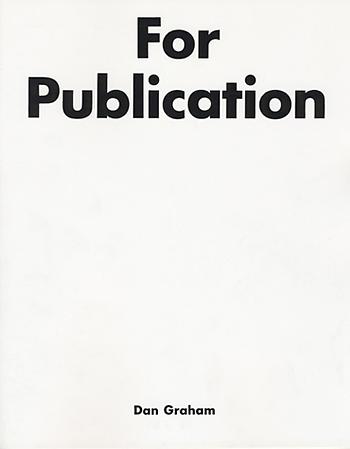
Dan Graham
For Publication
New York, Marian Goodman Gallery, 1991
27.5 x 22.5 cm
Reprint of the 1975 publication from Otis Art Institute Gallery, Los Angeles, which was itself a reprint of Graham’s pageworks of the 1960’s : including “Schema,” “Figurative,” “Information,” “March 31, 1966,” “Detumescence,” Magazine / Advertisments,” “Homes for America,” “Side Effects / Common Drugs,” “Likes,” “A Computer – Astrological Dating – Placement Service,” “Time Extended / Distance Extended,” “Income (Outflow) Piece,” “Proposal for Aspen Magazine,” and “Proposal for Art Magazine.”
… Through the actual experience of running a gallery, I learned that if a work of art wasn’t written about and reproduced in a magazine it would have difficulty attaining the status of ‘art.’ It seemed that in order to be defined as having value, that is as ‘art’, a work had only to be exhibited in a gallery and then to be written about and reproduced as a photograph in an art magazine. Then this record of the no longer extant installation, along with more accretions of information after the fact, became the basis for its fame, and to a large extent, its economic value.
From one perspective, the art object can be analyzed as inseparably connected to the institution of the gallery, or museum; but from another perspective it can be seen as having a certain independence, as it belongs also to the general cultural framework which the magazine is part of. Magazines specialize in a way which replicates other social economic divisions. Any magazine, no matter how generalized, caters to a certain market or specific audience in a particular field. All art magazines are directed to people who are involved in the art world professionally in one way or another. Furthermore, the art magazine itself is supported by advertisements which with one or two exceptions, come from art galleries who are presenting exhibitions. It follows that in some way the advertisers have to be taken care of in that their shows have to be reviewed and made a matter of record in the magazine. Thus these shows and works are guaranteed some kind of value and can be sold on the market as ‘art’. The fact that sales do take place yields enough money for the gallery to purchase more advertisements in art magazines and to sustain the art system in general.
…
If ‘Minimal’ art took its meaning from the notion that the gallery is an objective support, by comparison ‘Pop’ art took its meaning from surrounding media-world of images. ‘Pop’ wished to undermine the notions of quality in fine art by using mass-produced-cultural content. Since it fed its pictures through the magazines back into popular culture, ‘Pop’ art also made an ironic comment about popular culture to itself. What ‘Pop’ pointed out was that the information media, such as magazines, could be used dialectically with the art system. That is, a work could function in terms of both the art language and the popular language of the media at the same time, commenting upon and placing in perspective the assumptions of each. I designed works for magazine pages which would both be self-defined and would relate through their context, to the surrounding information on the other printed pages …— excerpt from “My Works for Magazine Pages ‘A History of Conceptual Art,'” by Dan Graham, 1985
Disponível em PDF: http://issuu.com/amir_brito/docs/for_publication?e=1780285/10308997
